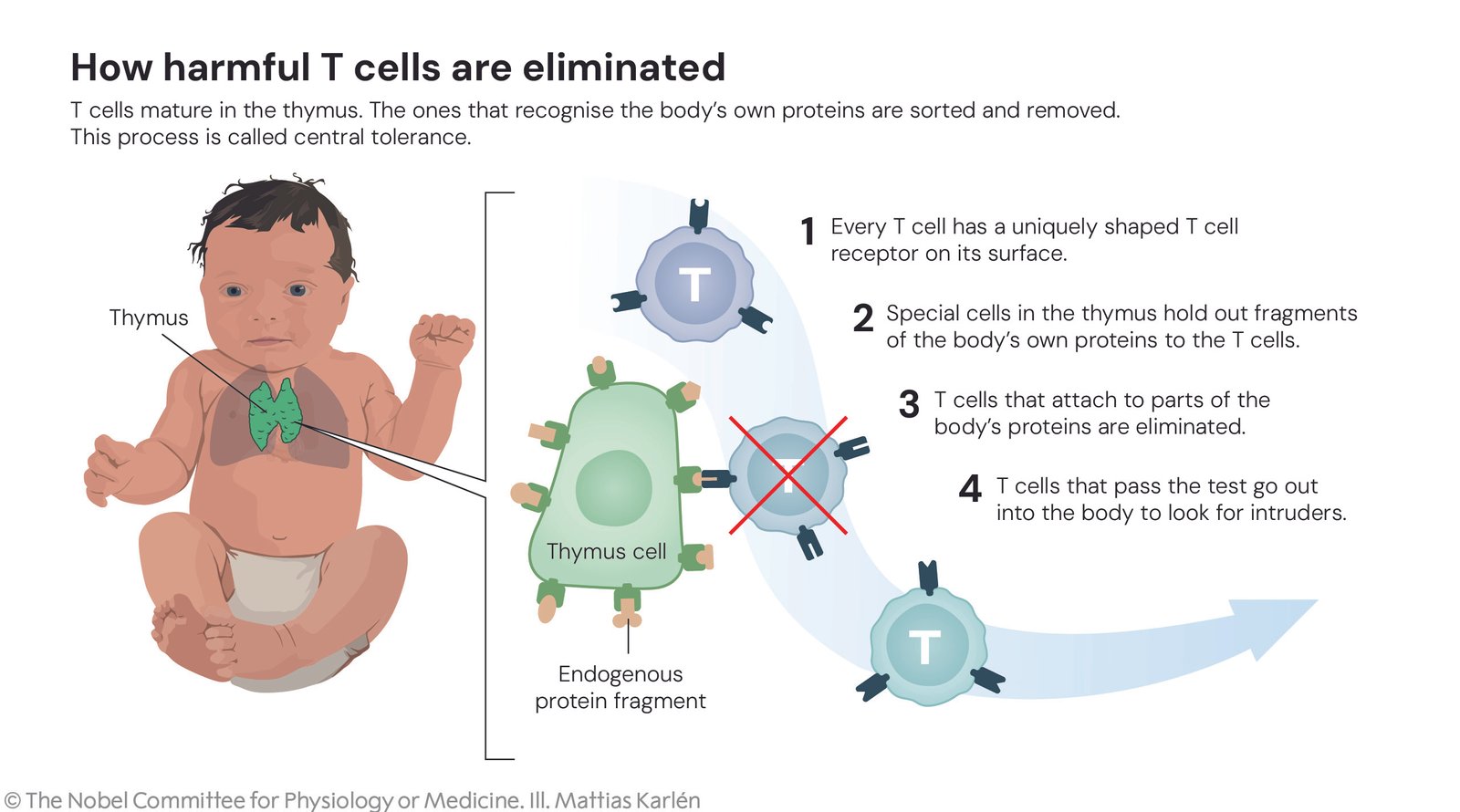New Delhi: The Nobel Assembly at Karolinska Institutet has announced that the 2025 Nobel Prize in Physiology or Medicine is jointly awarded to three scientists Mary E. Brunkow, Fred Ramsdell and Shimon Sakaguchi. They have been given this prestigious honor for their groundbreaking discoveries related to “peripheral immune tolerance” which has helped explain how our immune system stops itself from attacking our own body.
- What is this Revolutionary Discovery? The Immune System’s ‘Security Guards’
- Contribution of the Nobel Laureates
- Shimon Sakaguchi: Proof of the Existence of Regulatory T cells
- Mary Brunkow and Fred Ramsdell: Solving the Molecular Puzzle
- Medical and Future Applications of this Discovery
- Special for UPSC Aspirants (GS Paper 3: Science & Technology)
- Key Terminology
- Potential Preliminary Exam (Prelims) Question
- Potential UPSC Prelims Question
- Potential UPSC Mains Question (GS Paper 3 – Science & Technology)
Editorial note: This discovery redefines modern immunology by revealing how balance, not aggression, sustains life within the human body.
Their discoveries have laid a new foundation for research in the field of immunology and have raised new hopes for success in treating cancer, autoimmune diseases and complex procedures like organ transplantation.
What is this Revolutionary Discovery? The Immune System’s ‘Security Guards’
Our immune system is a wonderful biological mechanism that protects us daily from thousands of viruses, bacteria and other microbes. Its greatest feature is its ability to differentiate between external invaders (pathogens) and the body’s own cells. For decades scientists believed that this process primarily occurred through ‘Central Tolerance’.

Transition suggestion: To appreciate the depth of this discovery, it is essential to understand how this internal screening mechanism operates within the thymus and beyond.
Central Tolerance: This process takes place in the thymus gland where T cells mature. During this time those T cells that have the ability to recognize and attack the body’s own proteins are destroyed.
However this process is not infallible. Some self reactive T cells escape this check and enter the bloodstream. This is where the importance of this year’s Nobel Prize winning discovery comes to light. These three scientists discovered a second security mechanism called ‘peripheral immune tolerance’. The main heroes of this mechanism are Regulatory T cells or Tregs. These cells act as ‘security guards’ of the immune system calming down accidentally activated self reactive T cells and protecting the body from autoimmune diseases.

Bridge addition: Together, these two tolerance systems create a layered defense — one that trains the immune system and another that disciplines it when needed.
Contribution of the Nobel Laureates
This discovery is not the result of a single ‘Eureka’ moment but the culmination of decades of tireless work, challenging doubts and research conducted in different directions.
Insert line: Their combined pursuit not only changed how scientists view immunity but also restored faith in hypotheses once dismissed by mainstream biology.
Shimon Sakaguchi: Proof of the Existence of Regulatory T cells
In the 1980s and 90s when the idea of ‘suppressor T cells’ was almost rejected by the scientific community Shimon Sakaguchi of Japan did not abandon the concept.
He conducted experiments on mice whose thymus gland was removed a few days after birth. He found that the immune system in these mice became overactive and they developed several autoimmune diseases.
In a crucial experiment he showed that if mature T cells from healthy mice were injected into these mice they were protected from autoimmune diseases. This convinced Sakaguchi that a special type of ‘guard’ cell must exist in the immune system.
After more than a decade of hard work in 1995 he successfully identified these cells. He explained that these special T cells carry both proteins called CD4 and CD25 on their surface. He named them Regulatory T cells (Treg cells).

Add-on line: His perseverance marked a turning point — transforming a rejected concept into a cornerstone of modern immunology.
Mary Brunkow and Fred Ramsdell: Solving the Molecular Puzzle
While Sakaguchi was identifying Tregs Mary Brunkow and Fred Ramsdell in America were busy solving a different puzzle.
They were studying a special strain of mice named ‘scurfy’ which suffered from a severe autoimmune disease due to a genetic mutation and died within a few weeks. They knew that this mutation was located on the X chromosome.
With the limited technology of that time they started a task like finding a ‘needle in a haystack’ in a vast genetic landscape. After years of relentless effort they finally succeeded in finding the gene that had the mutation.
It was a previously unknown gene which they named Foxp3. They later also proved that a rare and fatal autoimmune disease in humans called IPEX syndrome is also caused by a mutation in this very gene.

Insert: This revelation provided the missing molecular link connecting immune regulation with genetic control — completing the picture Sakaguchi had begun.
The convergence of these two discoveries completely changed the picture of immunology. Subsequent studies have definitively proven that the Foxp3 gene is the ‘master switch’ that controls the development and function of regulatory T cells (Tregs).
Medical and Future Applications of this Discovery
The discovery of Treg cells and the Foxp3 gene has opened new avenues for treating diseases:
Intro line: These findings have not only explained the mechanism of tolerance but also inspired therapeutic strategies that bridge molecular biology and clinical medicine.
- Cancer Treatment: Many tumors gather Treg cells around them for their protection which prevents the immune system from attacking the tumor. Scientists are now developing drugs that can deactivate or remove these Treg cells so that the immune system can destroy cancer cells.
- Autoimmune Diseases: In diseases like arthritis, type 1 diabetes and inflammatory bowel disease the body’s immune system attacks its own tissues. In these cases the immune response can be calmed by increasing the number or functionality of Treg cells. Strategies like extracting Treg cells from patients increasing their numbers in the lab and then injecting them back into the body are being tested.
- Organ Transplantation: Treg cells can be used to prevent the rejection of transplanted organs which will reduce patients’ dependence on immunosuppressive drugs.
Add-on: These applications collectively signify a paradigm shift — from suppressing the immune system to guiding it toward harmony.
Special for UPSC Aspirants (GS Paper 3: Science & Technology)
This topic is extremely important for the UPSC Civil Services Examination. Questions can be asked from it in the Science and Technology section especially from biotechnology.
Editorial note: Aspirants should relate this topic with India’s growing biotechnology sector and national missions such as the National Biopharma Mission and ICMR’s Autoimmune Research Program.
Key Terminology
Immune Tolerance: The ability of the immune system by which it does not attack the body’s own healthy cells and tissues.
Central Tolerance: The process that occurs in the thymus gland where self reactive T cells are eliminated.
Peripheral Tolerance: The process that occurs in other parts of the body outside the thymus which controls the remaining self reactive T cells.
Regulatory T cells (Treg cells): Special immune cells with CD4+ and CD25+ markers which are important for maintaining peripheral tolerance and regulating the immune response.
Foxp3 gene: A ‘transcription factor’ gene that acts as a ‘master regulator’ for the development and function of Treg cells.
IPEX Syndrome: A rare severe autoimmune disease linked to the X chromosome caused by mutations in the FOXP3 gene.
Potential Preliminary Exam (Prelims) Question
Optional refinement: This question is excellent. For future pieces, you could add one conceptual UPSC-style analytical statement as a follow-up such as “Why is the concept of immune tolerance important for public health policy?”
Potential UPSC Prelims Question
Question: In the context of the 2025 Nobel Prize in Medicine, consider the following statements:
- Regulatory T cells (Treg cells) function to suppress the immune system and can be used by cancerous tumors for their defense.
- Foxp3 is a protein found on the surface of T cells.
- The process of central tolerance occurs outside the thymus.
Which of the above statements is/are correct?
(a) 1 only
(b) 1 and 2
(c) 2 and 3
(d) 1, 2 and 3
✅ Answer: (a) 1 only
Explanation: Statement 1 is correct. Statement 2 is incorrect because Foxp3 is a transcription factor gene not a surface protein. Statement 3 is incorrect because central tolerance occurs inside the thymus gland.
Potential UPSC Mains Question (GS Paper 3 – Science & Technology)
Question: Explain the concept of “Peripheral Immune Tolerance”. How has the 2025 Nobel Prize winning discovery in Medicine advanced this understanding and what are its potential therapeutic applications? (250 words)
Answer Outline:
Introduction: Define immune tolerance and differentiate between central and peripheral tolerance.
Significance of the Discovery: Mention the identification of Treg cells (CD4+CD25+) by Shimon Sakaguchi and the discovery of the Foxp3 gene by Mary Brunkow and Fred Ramsdell. Explain how Foxp3 was established as the master regulator of Treg cells which explained the molecular basis of peripheral tolerance.
Therapeutic Applications:
- Cancer: Breaking the tumor’s immune shield by targeting Tregs.
- Autoimmune Disease: Calming the immune system with Treg therapy.
- Organ Transplantation: The role of Tregs in preventing organ rejection.
Conclusion: Describe this discovery as a milestone in immunology highlighting future possibilities.
Closing line: The discovery thus stands as a testament to how curiosity-driven research can transform into clinical revolutions that redefine medicine and human health.

















